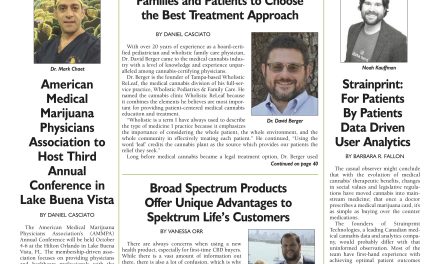By Jackie Rothman
The Mayo Clinic estimates that three million cases of Seasonal Affective Disorder (SAD) are reported annually. However, about 3% of Americans are estimated to experience the symptoms of SAD every year without addressing it with a healthcare provider.
The treatment options for Seasonal Affective Disorder are limited, but there is growing research into the prevalence of SAD among patients who have other mental health conditions, such as major depressive disorder or bipolar disorder.
Medical cannabis may offer help as a new alternative treatment. Particularly for patients who experience symptoms of SAD exclusively, without the presence of another mental health condition.
Conventional Treatment Options for Patients with SAD

A laboratory test to determine whether thyroid dysfunction or nutritional deficits are contributing factors can be conducted for the patient. An anxiety and depression scale can also be used to learn whether the patient has an undiagnosed mental health disorder.
There are four common methods of treating patients with Seasonal Affective Disorder. Often a combination of therapies may prove effective in helping reduce the severity of symptoms for patients.
- Light Therapy
Some patients can benefit from light therapy with an at-home device and guidance from their physician about exposure time and intensity. The recommendation is to use an at-home device that delivers 10,000 lux of light. An intensity that mimics exposure to natural sunlight to help with symptoms of SAD.
Many patients can benefit from daily light therapy and begin to notice a difference after three days. If a patient is not feeling relief after several days of exposure (usually two thirty-minute daily sessions), they can explore additional treatment options with a physician.
However, light therapy is not appropriate for all patients. Some people may experience nausea, headaches, and eye strain from light therapy. And it may not be suitable for patients on medications that cause photosensitivity or for individuals with Glaucoma or bipolar disorder.
- Psychotherapy
Some studies suggest that while psychotherapy can be beneficial for clinical anxiety or depression, results may be limited for seasonal affective disorder. That is because the triggers for SAD are temporary, resulting from daylight deficiency.
- Antidepressant Medications
One of the concerns about treating seasonal affective disorder with psychotropic medications is the short-term nature of symptom relief. If the patient does not have a diagnosis of clinical depression but rather transient seasonal symptoms, starting antidepressant medications for a four-month treatment period may be counterintuitive, particularly if patients experience pronounced side effects from antidepressant medications.
Wellbutrin XL is the only current FDA-approved medication for treating Seasonal Affective Disorder (SAD). Bupropion was first approved in 1985 for patients with Seasonal Affective Disorder, and it can be prescribed before the low-light season to help prevent symptoms from developing.
- Vitamin D Supplementation
Some studies have found that patients with Seasonal Affective Disorder have low levels of Vitamin D. However, more research is needed to determine if Vitamin D therapies can help patients with SAD.
Doctor-Supervised Cannabis for Seasonal Affective Disorder
Medical cannabis is another new therapeutic option for patients. Particularly for patients who have not felt improvement in their symptoms with other treatment modalities. And there can be many advantages to using medical cannabis to treat Seasonal Affective Disorder.
First, patients who do not present with other mental health concerns may choose a medical cannabis treatment plan. One that supports their need for mood regulation during the winter months, when symptoms of SAD are most prevalent.
Physicians can customize a temporary treatment plan that may offset lethargy and low mood symptoms. Physicians can recommend specific strains of Sativa medical cannabis or balanced hybrids. Particularly strains that have terpenes that may help reduce symptoms of apathy, irritability, insomnia, and depression.
Strains of medical cannabis that may provide a mood and energy boost include:
- Jack Herer
- Harlequin GDP
- Super Lemon Haze
- Lucid Blue
- Northern Lights
Cannabis strains frequently chosen to address symptoms of mood disorders may also help patients increase focus. One of the frequent complaints patients share about some antidepressant medications is drowsiness and difficulty with concentration. For some, medical cannabis may help improve mood while maintaining alertness.
Medical Cannabis as a Complementary Treatment With Other Therapeutic Options
The medical cannabis evaluation required to become a registered patient includes a thorough review of medications, diagnoses, and patient health history. A physician has the opportunity to make doctor-supervised cannabis part of a comprehensive treatment plan to address symptoms of Seasonal Affective Disorder (SAD).
Jackie Rothman is Chief Operating Officer at DocMJ. www.docmj.com










